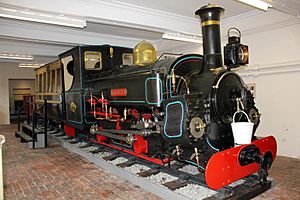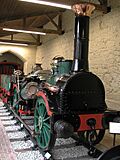Penrhyn Castle Railway Museum facts for kids

Charles, a famous steam engine from the Penrhyn Quarry Railway.
|
|
| Lua error in Module:Location_map at line 420: attempt to index field 'wikibase' (a nil value). | |
| Established | 1951 |
|---|---|
| Location | Llandygai, Gwynedd, Wales |
| Type | Railroad museum |
| Owner | National Trust |
The Penrhyn Castle Railway Museum is a special museum about trains located at Penrhyn Castle near Bangor in Wales. It celebrates the history of industrial railways, which were trains used for work, not for carrying passengers.
In the 1800s, Penrhyn Castle was home to the Pennant family. They owned the huge Penrhyn slate quarry, where slate for roofs was dug out of the ground. To move all that heavy slate, they used a special railway called the Penrhyn Quarry Railway (PQR). This was one of the first industrial railways in the world.
The railway line ran very close to the castle. In 1951, the castle was given to the National Trust, a charity that protects historic places. They decided to create a museum in the castle's old stables to show off some of the amazing trains and tools from the quarry.
The first engine given to the museum was a steam locomotive named Charles. Over time, the museum collected many other important engines from Britain's industrial past.
In 2024, the museum began to change. Most of the locomotives were moved to other railway museums where they could be cared for and displayed. The space at Penrhyn Castle is now part of a new exhibit called "Industrial Penrhyn," which tells the story of the area's industrial history.
Famous Locomotives of the Museum
Here are some of the historic steam engines that were part of the museum's collection. The table shows where many of them have been moved to.
| Name | Image | Gauge | Builder | Type | Date | Works number | Notes |
|---|---|---|---|---|---|---|---|
| Charles |  |
1 ft 10 3⁄4 in (578 mm) | Hunslet | 0-4-0ST | 1882 | 283 | Worked on the Penrhyn Quarry Railway. This engine is staying at the castle as part of the new "Industrial Penrhyn" museum. |
| Hugh Napier |  |
Hunslet | 0-4-0ST | 1904 | 855 | An engine from the Penrhyn Quarry. It was moved to the Ffestiniog Railway and fixed up to run again in 2012. | |
| Fire Queen |  |
4 ft (1,219 mm) | A. Horlock and Co | 0-4-0 tender | 1848 | Worked on the Padarn Railway. In 2024, it was moved to the Vale of Rheidol Railway. | |
| Watkin | 3 ft (914 mm) | De Winton | 0-4-0VBT | 1893 | From the Penmaenmawr & Welsh Granite Co. quarry. | ||
| Kettering Furnaces No. 3 |  |
Black, Hawthorn & Co | 0-4-0ST | 1885 | 859 | Used on the Kettering Ironstone Railway. It was given to the Waterford and Suir Valley Railway in 2024. | |
| No. 1 |  |
4 ft 8 1⁄2 in (1,435 mm) standard gauge | Neilson and Company | 0-4-0 | 1870 | 1561 | From the Beckton Gas Works railway. It moved to the Museum of Scottish Railways in early 2024. |
| Hawarden |  |
Hudswell Clarke | 0-4-0ST | 1899 | 526 | From Globe Ironworks in Stalybridge. It was given to the Middleton Railway in 2024 and is now on display. | |
| Vesta |  |
Hudswell Clarke | 0-6-0T | 1916 | 1223 | From the Hawarden Bridge steel works. It was given to the East Lancashire Railway in 2024 and is displayed in the Bury Transport Museum. | |
| Haydock |  |
Robert Stephenson & Co | 0-6-0T | 1879 | 2309 | From the Haydock Collieries Railway. It was moved to the Isle of Wight Steam Railway in 2024. |
See also
- British narrow-gauge railways

